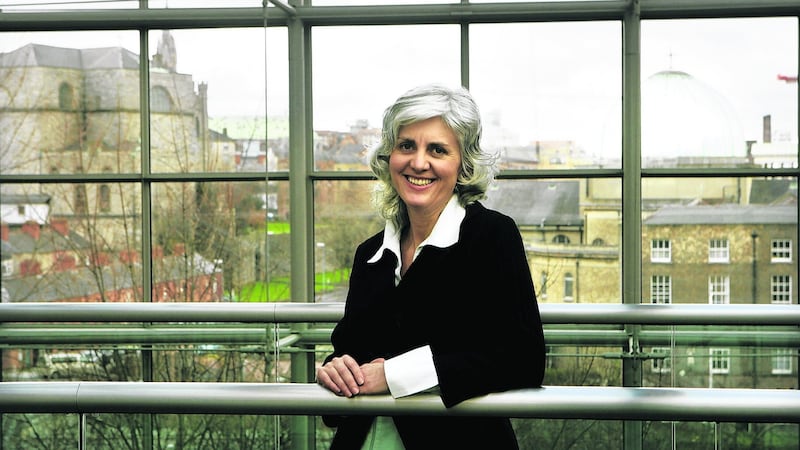Apartment living is the future for our cities, according to Dublin City Architect Ali Grehan. Speaking at the Academy of Urbanism (AoU) conference on Urban Futures in Dublin Castle last week, Grehan said, "It is about density. Our household sizes are falling. Not everyone needs a four-bedroom house. We have to look differently at apartment living. It could be wonderful, with communal spaces where neighbours meet and chat."
However Grehan added that "the biggest challenge for Dublin is to create inclusive, safe, resilient, sustainable communities in our cities." More than 70 per cent of people who live in Dublin city centre rent and the vast majority of these renters were born outside of Ireland.
"The perils of suburbs have been overstated and Dublin suburbs are some of the nicest places to live in the world. But, go to Aldi on Parnell Street and you won't meet one Irish person," said Grehan. "We have to get real about our city centres and discover how to make cities and towns places to live in by choice, not by necessity."

Powerful independent leadership from long-serving mayors has been a factor in developing other European cities, according to Grehan.
With more than 500 international members from planning and architectural professions, the AoU celebrates the best examples of urbanism in cities, towns, neighbourhoods and streets in its annual award scheme. Its 200 “Young Urbanists” are students and young professionals who are interested in fields such as planning and design, development and globalisation, community and politics, and the arts.
Millennial workers
The theme of the Dublin conference was “Urban Future, Cities & Towns in Transition” and delegates also heard how responding to so-called millennial workers will create vibrant city centres. These millennial workers (born between 1985 and 2000) are at ease working in cafes or hosting meetings in informal innovation hubs at train stations, airports and funky warehouses. Millennial workers also like to live close to where they work and are happy to take public transport because it keeps them connected to wifi.
Roger Hobkinson from Colliers International said that out-of-town office parks won't attract these workers. "The cool kids want to be in attractive urban offices, not out-of-town business parks."
Urbanists claim the architectural response should be to turn the core of city- centre office blocks into informal semi-public spaces for transitory use.
“We’ve got to be more imaginative about the urban block, breaking it down into plots with semi-public spaces inside and disappearing gaps between indoor and outdoor spaces,” said John Worthington, commissioner of the UK Independent Transport Commission and past director of the Academy of Urbanism.
Speaking about unclogging cities like Dublin of road traffic, Worthington added, “young people living in cities are not buying cars. We need to have a clear value system that we want a community that uses fewer cars with the promotion of walking, cycling and public transport to link places other than city centres.”
Train stations can even become active public spaces with Rotterdam station cited as an example where classical concerts are held on Sunday mornings.
Conservation architect Grainne Shaffrey spoke about the need for a wider brief for the Living City Initiative if Dublin city is to deal with vacant and dilapidated historic buildings. This is a scheme of property tax incentives which applies in certain "special regeneration areas" in the centres of our cities. It is currently under review by the Department of Arts, Heritage, Regional, Rural and Gaeltacht Affairs. Shaffrey said for it to be effective it must be open to both developers and owner-occupiers.
Abandoned buildings
“Other cities haven’t abandoned their historic buildings in the same way as Dublin has. The Living City Initiative should be opened up to mixed-use Georgian buildings in the South and North of the city,” she said. “There is a big cost in changing the use of these buildings from offices to mixed use with offices on the lower floors and residential on the upper floors.”
Shaffrey also noted a concern that smaller brown-field sites in the city centre will be neglected in the current burst of housing developments.
“It would be a pity if we are left with decrepit, rundown parts of the inner city. The city council could take control of these sites, put plans in place and release them with planning permission. It’s more about delivering something well rather than extracting only economic profit.”
She said Dublin needs to become a more walkable city with more wide footpaths, less on-street car parking and more trees. “Dublin is a small compact city. It should be more walkable.”
Wider debates were also held on how Modernist architecture failed people by creating zoned areas for living and working linked only by road networks. The New Urbanists seek to reclaim cities and towns to live and work in.
Visitors to Dublin were given architectural tours of Temple Bar and the Dublin Docklands as examples of urban regeneration.
On the fast track: Minister outlines plan for housing
The Minister for Housing, Planning and Local Government, Simon Coveney, outlined his action plan for housing at the Urban Futures conference in Dublin Castle . He spoke about new legislation which will enable the fast tracking of planning for housing developments with more than 100 units.
"This will allow developers to send applications directly to An Bord Pleanála and have a yes or no decision within 18 weeks. The onus will be on the applicant to have high-quality applications.
“Our aim is to create more diverse, healthy and vibrant mixed communities with high-quality design where it’s not obvious what’s public and what’s private housing,” said the Minister.












